Don't wanna be here? Send us removal request.
Text
Patient Portal Software

Patient Portal Software is an online platform where patients can access their health information. It allows them to view from any location.
Key Features of Patient Portal:
Accessibility: Patients can easily access their medical records from anytime and anywhere with secure internet connection.
Secure Communication: Patients can communicate directly with their healthcare providers regarding their medical conditions.
Appointment Scheduling: Appointment can be scheduled online according to the convenient time and this reduces the waiting time.
Prescriptions Refills: Prescriptions can be refilled again through online, this avoids hospital visits for medications.
Billing & Payments: Payments can be made through online billing instantly.
How Patient Portal can be utilized effectively:
Improved Patient Care: Healthcare providers can share patient information with other providers and can provide the best treatment. This improves patient care coordination.
Patient Engagement: There is an increase in patient engagement as they can track their health information, set goals and monitor their health progress.
Lab Reports Access: Patients can view their lab results easily through the DICOM reader.
Cost-Reduction: As patients can view their reports and schedule appointments online it reduces the in-person visits cost.
In Vozo, we provide various services related to patient portal software. Patient Portal Software is cost-effective, increasing patient engagement, communication is done securely.
0 notes
Text
Robotic Process Automation
Robotic Process Automation helps healthcare providers automate routine tasks. It reduces human effort and improves efficiency in daily operations. RPA uses software bots to handle scheduling, billing, and claims processing. These bots work quickly and minimize errors in administrative processes.
Key Benefits of using RPA in Healthcare include:
Faster Insurance Claims: Automates submissions and speeds up payment processing for providers.
Fewer Mistakes: Reduces errors in data entry and medical billing tasks.
Better Compliance: Ensures patient data accuracy and meets regulatory healthcare requirements.
Improved Patient Experience: Reduces waiting times and sends automatic appointment reminders.
Cost Savings: Cuts administrative expenses by reducing manual work in offices.
Additionally, RPA integrates with Electronic Health Records (EHR) for data consistency. This integration ensures healthcare professionals access patient information in real-time. Hospitals also use RPA for inventory tracking and supply management.
As a result, healthcare services become more efficient and cost-effective. The demand for automation in healthcare continues to grow rapidly. In the future, RPA will play a greater role in operations.
0 notes
Text
What technologies are essential for Telehealth to function effectively?
Effective telehealth relies on integrating advanced technologies to deliver seamless, patient-centered care. Key telehealth features include secure video conferencing, real-time messaging, and remote monitoring with wearable devices that track vitals like heart rate. For mental health, telehealth EHR systems offer specialized templates, progress tracking, and strict privacy compliance. Telehealth integration ensures interoperability through API connectivity and unified dashboards, while telehealth software leverages cloud-based systems and AI tools for scalability and enhanced functionality. Wearable devices further enrich care by providing real-time health data to clinicians. Additionally, telehealth EHR integration enables seamless syncing of patient records, appointment management, and data-driven insights. Finally, a robust telehealth engagement strategy, with user-friendly platforms and educational resources, enhances accessibility and patient satisfaction.

#best telehealth#best telehealth software#telehealthservices#telehealth features#telehealth integration
0 notes
Text
Role Of OpenEMR
Rural health centers (RHCs) face numerous challenges, including limited resources and geographical barriers.
To enhance efficiency, RHCs can utilize health tech solutions like OpenEMR, an open-source electronic medical records system that provides customizable and scalable options tailored to their needs.
OpenEMR has various key Benefits for Rural Health Centers:
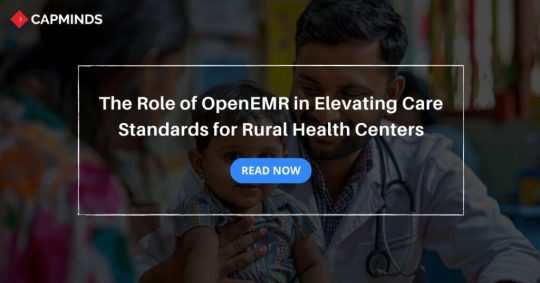
Supports telehealth helps to expand patient reach.
Automates administrative tasks which leads to reducing patient wait times.
Centralizes patient data for better care coordination.
Makes it easier for proactive monitoring of conditions.
Offers robust reporting for improved quality of care.
Enables secure data exchange with other organizations.
Ensures HIPAA compliance to protect patient information.
Adapts to evolving needs and workflows.
Reduces licensing costs and boosts revenue cycle efficiency.
0 notes
Text
AI IN OpenEMR
Exclusive webinar for healthcare professionals across all specialties and roles. Led by our distinguished speaker, Cyril Verbine, this session will demonstrate how OpenEMR and AI integrations can revolutionize patient care and practice management in any healthcare setting.
youtube
#ai #healthcare #openemr #patientcare #medical #healthcareprofessionals #clinics #doctors #webinar #live #patient #emr #healthtech
#ai#healthcare#openemr#patientcare#medical#healthcareprofessionals#clinics#doctors#webinar#live#patient#emr#healthtech#Youtube
0 notes
Text
The Role Of OpenEMR in Elevating Care Standards for Rural Health Centers
Rural health centers face many challenges. It includes limited resources, geographical barriers, and difficulties in providing care. So, to achieve maximum efficiency, rural health centers must rely on health tech solutions. However, OpenEMR, an open-source electronic medical records system provides a comprehensive solution for rural health centers.
It offers cost-effective, customizable, and scalable solutions. In this blog post, we have shared how OpenEMR fits into the operations of rural health centers and optimizes workflow.
What are Rural Health Centers?
Rural Health Centers (RHCs) are healthcare facilities specifically designed to serve rural communities & provide accessible healthcare services to residents in those areas.
These centers are vital for addressing rural populations’ unique healthcare challenges, including limited access to healthcare facilities, shortages of providers, and socioeconomic disparities.
RHCs play a crucial role in ensuring that individuals living in rural areas have access to primary care, preventive services, and essential healthcare resources. They typically offer a range of services, including but not limited to:
1. Primary Care
RHCs serve as primary care providers for rural residents, offering comprehensive healthcare services, routine check-ups, management of chronic conditions, and preventive care.
2. Urgent Care
Many RHCs provide urgent care services to address immediate medical needs like minor injuries, illnesses, and infections that require prompt attention but do not require emergency room care.
3. Preventive Services
RHCs focus on preventive care, including vaccinations, screenings, health education, and counseling to promote wellness and disease prevention within the community.
4. Chronic Disease Management
RHCs often specialize in managing chronic conditions such as diabetes, hypertension, asthma, and heart disease. They provide ongoing care, medication management, and patient education to help individuals effectively manage their conditions.
5. Telehealth Services
RHCs have increasingly adopted telehealth services to reach patients remotely in recent years. Telehealth allows rural residents to receive healthcare consultations, follow-ups, and specialist referrals without traveling long distances.
Related: The Integration of Telehealth with OpenEMR: What You Need to Know
6. Behavioral Health Services
Many RHCs integrate behavioral health services to address mental health issues prevalent in rural areas. This may include counseling, therapy, substance abuse treatment, and referrals to mental health specialists.
7. Women’s Health
RHCs often offer women’s health services, including prenatal care, family planning, gynecological exams, and screenings for breast and cervical cancer.
8. Care Coordination
RHCs are vital in coordinating care for their patients. They work closely with other providers, specialists, hospitals, and community resources to ensure continuity of care and appropriate referrals.
Benefits of OpenEMR Solution for Rural Health Centers
OpenEMR fits seamlessly into rural health centers and elevates their operations and services in several ways.
1. Improved Access to Care
OpenEMR enables rural health centers to provide better access to care for individuals in remote areas
The software supports telehealth integration, allowing providers to deliver virtual consultations, follow-ups, and monitoring
This expands the reach of the rural health center, ensuring that patients can receive timely care without the need for long-distance travel
2. Enhanced Efficiency
OpenEMR streamlines administrative tasks and reduces manual paperwork. It automates processes like appointment scheduling, patient registration, and billing, freeing up staff time and resources
This increased efficiency allows rural health centers to serve more patients, minimize wait times, and improve overall patient satisfaction
3. Comprehensive Patient Record Management
OpenEMR centralizes patient records, making them easily accessible and searchable
Providers in rural health centers can access patient demographics, medical history, lab results, medications, and allergies in real-time
This comprehensive view of patient data improves care coordination, enables informed decision-making, and enhances patient safety
4. Better Chronic Disease Management
OpenEMR supports the management of chronic conditions commonly found in rural areas, such as diabetes, hypertension, and respiratory diseases
The software facilitates medication management, monitoring of vital signs, and documentation of treatment plans
This promotes proactive care, empowers patients to self-manage their conditions, and reduces hospitalizations
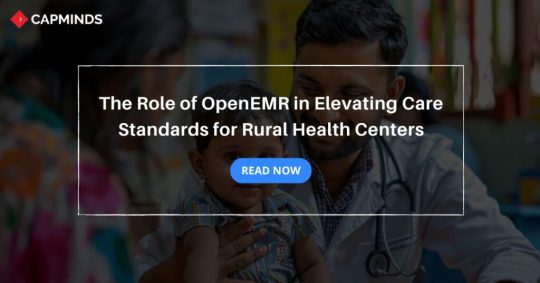
5. Data-Driven Decision-Making
OpenEMR provides robust reporting and analytics capabilities
Rural health centers can generate customized reports on patient outcomes, disease trends, and resource utilization
These insights help administrators and healthcare providers identify areas for improvement, allocate resources effectively, and make data-driven decisions to enhance the quality of care.
6. Seamless Care Coordination:
OpenEMR supports interoperability, enabling rural health centers to exchange patient data securely with other healthcare organizations and systems
This facilitates seamless care coordination, referral management, and transitions of care for patients who require specialized services beyond the capabilities of the rural health center
It helps avoid redundant tests, improves communication, and ensures continuity of care
7. Compliance & Security
OpenEMR adheres to healthcare regulations, including HIPAA compliance, safeguarding patient privacy, and data security
This is essential for rural health centers that handle sensitive patient information
OpenEMR includes features like access controls, audit logs, and data encryption, ensuring that patient records are protected and rural health centers maintain compliance with regulatory requirements
8. Customization & Scalability
OpenEMR’s flexibility allows rural health centers to customize the software to meet their specific needs
The system can be tailored to accommodate unique workflows, templates, and forms. Additionally, OpenEMR is scalable, adapting to the growth and evolving requirements of rural health centers as they expand services or acquire additional facilities
9. Cost-Effectiveness and Financial Benefits
OpenEMR, therefore, benefits rural health centers through cost-effectiveness, which is one of the strengths of this software.
Another benefit of their EMR solution is that being an open-source software facility located in rural areas do not have to pay for licenses for proprietary software.
In addition, OpenEMR allows for increasing the efficiency of the revenue cycle by enhancing the effectiveness of billing and coding.
It helps to speed up the process of reimbursement from payers and stabilizes the financial conditions of the underfunded rural centers.
Related: Empowering Underserved Communities with OpenEMR to Easily Climb Up
If rural health centers looking to add more facilities, no software can be compared to OpenEMR in terms of scalability.
No matter the increase in newly added services such as behavioral health or the need to expand telehealth services the system explained works to continue growing and sustaining the healthcare facility.
Case Study of OpenEMR Implementation in US Rural Centers
OpenEMR has already been adopted by rural health centers all over the U. S. to enhance the delivery of their health care services. For instance, a community health center in Georgia reported:
40% boost in the patients’ satisfaction level
30% reduction in manual paperwork mistakes
after adopting the OpenEMR solution within half a year.
This success story shows the fact that through the use of OpenEMR healthcare organizations achieve operational effectiveness in addition to delivering superior patient care outcomes.
CapMinds OpenEMR Customization and Integration Solution
Need assistance with OpenEMR for your healthcare practice?
Trust CapMind’s expert OpenEMR customization and integration services. As a leading health tech company, we understand the unique challenges you face.
Our tailored solutions ensure a seamless transition to OpenEMR, maximizing efficiency and minimal workflow disruption. Our Service includes:
Customized setup to fit your specific needs
A low-cost solution for your practice’s long-term future.
Comprehensive staff training and ongoing tech support.
Modern User Interface (UI) customization
Integration with third-party tools and APIs
Don’t let outdated systems hold you back. Embrace the future of healthcare management with OpenEMR. Our experienced team will guide you every step of the way, from initial consultation to full implementation.
Contact CapMinds today for a free consultation and discover how OpenEMR can transform your healthcare delivery.
0 notes
Text
The Trending HL7 Interface Engine

Mirth Connect is an open-source, healthcare interface engine that connects many health information technology systems for a faster, easier and more secure exchange of messages.
Mirth integration tools make integration easier and accept almost all top-running message standards like HL7, EDI, X12, etc. This software helps to navigate and translate data from one computer system to another.
0 notes
Text
Remote Patient Monitoring
Remote patient monitoring (RPM) significantly enhances care for chronic conditions like diabetes. With over 570 million adults worldwide affected by diabetes, preventative care is vital in reducing risks by:
Providing real-time health data to providers. Proactive interventions help prevent complications. Enhances patient engagement and outcomes.
Discover the benefits and challenges of integrating RPM and preventative care into diabetes care:
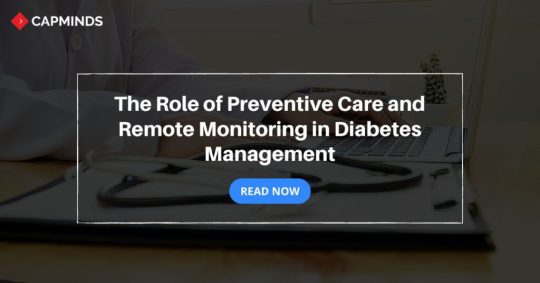
1 note
·
View note
Text
Telehealth
Engage your patients efficiently at their convenience at home. Get access to the best telehealth service and manage your patient's health anywhere in the world.
Our telehealth services with a vast range of features like appointment scheduling, easy onboarding, and integrated telemedicine allow you to encourage your patients to be actively involved in their healthcare journey.
Vozo telehealth service offers a great opportunity for healthcare providers to have in-house specialists consult to provide quality care for patients which ultimately leads to an increase in revenue. We Empower patients with online appointment scheduling features that enable the patients to schedule appointments with the healthcare providers.
It’ll make it easier for you and your patients to schedule appointments that are more convenient for both. However, healthcare providers can reduce the no-show of the patients as our telehealth platform sends automated real-time alerts beforehand to ensure the patients don’t miss the appointment. Moreover, our platform helps you and your patients to connect online via messaging, video calls, and chat, to offer health consultation remotely.
Over 100+ healthcare practices in the US and Canada have benefited from the Vozo Telehealth platform for seamless workflow and to provide better patient care conveniently. Reach out to Vozo and empower your patient's well-being conveniently.

#Telehealth USA#best telehealth#best telehealth software#Top telehealth software#affordable telehealth
0 notes
Text
Online Scheduling Setup Guide: Appointment Flexibility for Your Patients
To enhance the patient's overall experience, the online scheduling software must be rightly set up. This online scheduling setup guide will assist you in need.
Before technological advancement, patients used to travel to the healthcare practice to schedule appointments with healthcare professionals.
According to a survey, patients have to wait around 20 to 30 Minutes in the healthcare practice just to book an appointment with healthcare professionals in their available time.
That’s not the real thing, If making an appointment with healthcare professionals takes 20 to 30 Minutes means, How long do the patients have to wait after getting the appointment?
Then the appointment scheduling via phone call was raised.
According to a source, Only 50% of the patients have scheduled appointments on their first call.
Nowadays, patient scheduling become an easy task for patients through online scheduling.
Healthcare practices have significantly adopted Online appointment scheduling which makes prospecting easier for both patients and providers.
Moreover, patients can use the self-service portal to schedule appointments by themselves.
This blog post will walk you through the Online Scheduling Setup to make scheduling easier for your patients.
What is Online Appointment Scheduling?
Online Appointment Scheduling is a feature in Patient Portal Software that allows patients to schedule appointments with healthcare professionals for checkups conveniently.
This convenience prevents patients from in-person visits to the healthcare practice to schedule appointments, reduces the waiting time, etc.
Here are the key benefits of online patient scheduling;
Better Patient Experience
Time and Money Saving
Workflow Efficiency
Increased Availability
Enhance Convenience
Easy Resource Allocation
Reduce Administrative Workload
Streamline Data Management
And More.
Online Patient Appointment Scheduling Guide (Step-By-Step Process)
Online patient appointment scheduling has become a crucial aspect of the healthcare industry to streamline patient experience and workflow efficiency.
Implementing an online appointment scheduling system requires carefully curated planning and execution.
Here is the step-by-step process for setting up online appointment scheduling for patients;
Step 1: Define the Objectives and Requirements
Before beginning to set up the online appointment scheduling system, the healthcare providers should define the objective of implementing online appointment scheduling.
Here are the few objectives and requirements that healthcare providers should consider;
Number of Healthcare Providers
Types of Services Offered
Patient Demographics
Outline the essential features and functionalities required such as calendar integration, real-time availability, and automated reminders.
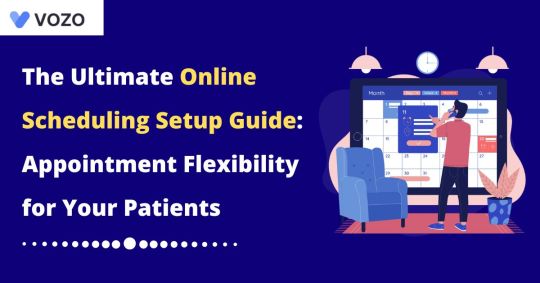
Step 2: Choose a Reliable Scheduling Software
Choosing reliable patient appointment scheduling software that aligns with your healthcare specialty is crucial.
Moreover, healthcare practice should consider a few factors while choosing the best scheduling software;
Cost-Efficiency
User-Friendliness
Integration capabilities
Security features
Scalability
There are a few factors you should consider.
While there are many software available on the internet, Vozo stands top as the best appointment scheduling software by meeting all the needs and requirements.
With the help of Vozo’s appointment scheduling software, patients and healthcare providers can streamline the workflow and improve efficiency.
Our client-friendly subscription plan benefits healthcare practices of all levels.
Step 3: Integrate with EHR (Electronic Health Records)
Seamless integration of Appointment scheduling software with EHR (Electronic Health Records) is essential to streamline the workflow without any errors.
This integration of appointment-scheduling software with EHR allows;
Automatic updates of patient records to the EHR system.
Reducing the risk of manual errors.
Improving overall work efficiency.
Step 4: Customize Appointment Types and Durations
Healthcare providers should customize the online scheduling system for different types of appointments like general checkups, follow-ups, dentists, eye doctors, gynecologists, dermatologists, etc, and varying the durations of services provided.
This customization of appointment types and durations ensures that the appointment scheduling system aligns with the specific needs of your healthcare providers and the nature of the appointments they offer.
Step 5: Setup User-Friendly Interface
A Most important step of online scheduling setup is setting up the user-friendly interface of the online scheduling software.
The Complex user interface might disrupt the workflow and make it difficult to manage.
Design a simple easy-to-access user interface for both healthcare providers and patients.
The scheduling platform should be easily accessible across various devices, ensuring a seamless experience for users.
Step 6: Implement Real-time Availability
Enable real-time healthcare provider's availability for patients to book appointments based on the current healthcare provider's availability.
The Real-time availability prevents double booking and provides an accurate representation of each provider’s availability.
Step 7: Configure Automated Reminders
Implement automated reminders and confirmation features to reduce the no-shows and improve overall appointment attendance.
Healthcare providers should configure automated reminders via SMS, Notifications, Email, etc to alert the patients of their appointments beforehand.
And also to provide the necessary instructions for patients for their appointments.
Step 8: Train Staff and Providers
Healthcare practice should conduct a training session for the healthcare staff and providers to educate them on the appointment scheduling system.
Ensure that they understand;
How to navigate the appointments
How to manage appointments efficiently
How to utilize additional features to improve patient engagement.
These are effective guides to completely setting up the appointment scheduling software for a seamless patient experience.
Challenges of Appointment Scheduling Software for Both Patients and Providers
While it offers various benefits, there are a few challenges that patients and providers have to face with appointment scheduling software.
Here are the few challenges patients and providers faced with the online scheduling software;
Patients find it difficult to fill out the appointment form resulting in losing.
Challenges with technological booking hurdles.
If the appointment scheduling software stops working, the appointments and customers may be lost.
To use appointment scheduling software efficiently, healthcare practices and patients need an internet connection.
The Cost of Implementing Appointment scheduling software can cost high that not all levels of healthcare practice can able to invest.
These are the challenges with appointment scheduling software that healthcare providers and patients need to navigate for a seamless online appointment booking experience.
Vozo’s Appointment Scheduling Software for Seamless Experience
The Appointment Scheduling software makes the workflow easier for both patients and healthcare providers.
Patients can save time and money by scheduling appointments at the convenience of their homes and healthcare practices can increase their revenue by providing seamless experience for patients.
However, choosing the right online appointment scheduling software is necessary.
If you are searching for the best online appointment scheduling software, Vozo provides a comprehensive solution for patients and providers.
Our solution will help you to navigate all the challenges with the appointment scheduling software with ease.
Simple customized appointment form templates for specialty.
Easy user interface to reduce technical difficulties.
Support team with 24/7 availability.
Cost-effective subscription plan that benefits all levels of healthcare practices.
Training sessions and resources to educate providers and healthcare staff.
And more. Experience seamless appointment scheduling and managing appointments with ease. Reach out to Vozo and Make the appointment scheduling procedure easier for patients.
#best patientportal#best practices#patient appointment#online scheduling#healthcare#healthcare organizations#patient management#online patient scheduling
0 notes
Text
Vozo Telehealth
Telehealth refers to the use of digital healthcare technologies to provide healthcare services remotely. It encompasses a variety of services and applications, including virtual consultations, remote monitoring, telemedicine, and other forms of digital health. Telehealth has gained significant importance, especially in recent years, due to advancements in technology and the need for accessible healthcare services.
Virtual Consultations: Patients can interact with healthcare professionals through video calls, phone calls, or online messaging platforms. This allows for remote diagnosis, consultation, and follow-up care.
Remote Monitoring: Devices and sensors can be used to collect and transmit patient data, enabling healthcare providers to monitor vital signs, chronic conditions, and overall health remotely.
Telemedicine: This involves the use of technology to deliver medical services, including diagnosis and treatment, from a distance. It may include the exchange of medical information through secure platforms.
Mobile Health (mHealth): The use of mobile devices, such as smartphones and tablets, to support healthcare services, including apps for symptom tracking, medication reminders, and virtual consultations.
Store-and-Forward: Healthcare providers can securely share patient information, such as medical records, images, and test results, for consultation with specialists at a later time.
Benefits of telehealth include:
Increased Access: Telehealth makes healthcare services more accessible, especially for individuals in remote or underserved areas.
Convenience: Patients can receive medical care from the comfort of their homes, reducing the need for travel and saving time.
Cost-Efficiency: Telehealth can reduce healthcare costs for both patients and providers by minimizing the need for physical infrastructure and travel expenses.
Improved Monitoring: Remote monitoring of patients with chronic conditions allows for proactive care and early intervention.
Despite its advantages, telehealth also faces challenges, including issues related to privacy and security, regulatory considerations, and the need for reliable internet connectivity. As technology continues to advance and healthcare systems adapt, telehealth is expected to play an increasingly significant role in delivering healthcare services.
#Telemedicine#Telemedicine software#Telehealth#Telehealth software#cost effective telehealth solutions#Vozo telehealth#best telemedicine platform#HIPAA Compliant Telehealth#Telehealth EHR integration
0 notes
Text
Need help to streamline reimbursement processes in your large hospital?
Our latest blog post has a breakdown of the Best Vozo EHR system, providing insights on how to optimize reimbursement for your large-scale healthcare institution effortlessly.
Explore How Major Healthcare practices saw significant improvement within a year of opting Vozo EHR system and clinical workflows.
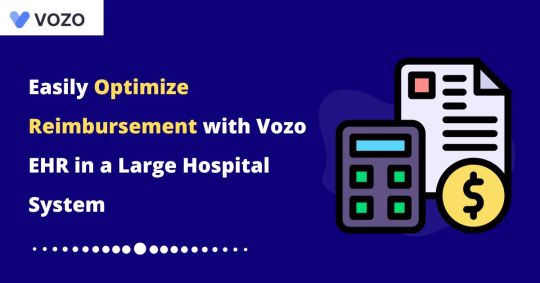
From simplified coding to real-time claim tracking, Vozo EHR ensures your hospital system operates at peak financial performance.
0 notes
Text
vozoehr
As the Necessity of the EHR system in healthcare practice, Vozo strives to provide the best EHR system to help provide better healthcare practice for patients and increase in revenue.
Our EHR solution is designed for smart workflow, managing the patient's records safely, and securely in a well-organized way.
Vozo EHR system offers a vast range of features that are especially US healthcare practices;
Easy-to-Use User Interface: Our simple system interface ensures that non-technical staff can find easy-to-manage records in the Vozo EHR system.
Customized Templates: The Vozo EHR system allows you to save time in creating documents from scratch. With customized documentation, you can speed up the process of documenting health records.
Seamless Integration: Vozo EHR seamlessly integrates with other modules like e-prescribing, lab integration, and other modules.
Patient Portal: Our Electronic Health Record (EHR) system provides patients with easy access to their medical records, and the ability to schedule appointments, request prescription refills, and view complete medication history.
Revenue Cycle Management: Our team of experts can guide you through the whole RCM process, from start to finish, ensuring optimal revenue for your practice.
Billing and Reporting: Managing your medical practice has never been easier with Vozo. Schedule appointments, submit claims, pay bills online, and streamline your workflow seamlessly.
Telehealth Software: Our software enables patients to have virtual visits directly from the EHR system, providing improved patient care in a secure online platform.
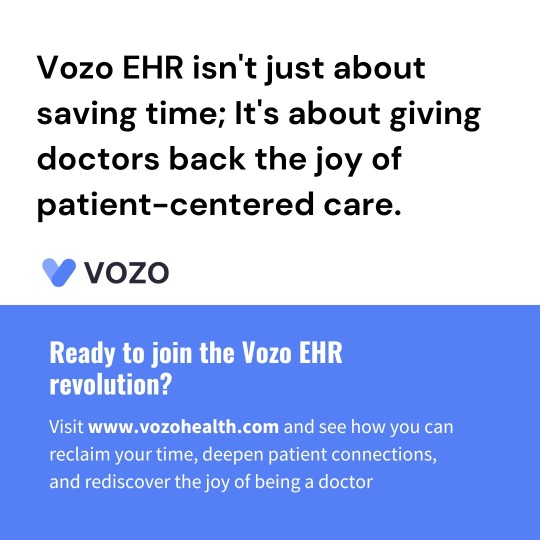
#best ehr for mental health#ehr pricing models#provider#patientportal#best patientportal#ehr#chroniccare managemnet
0 notes
Text
VOZOEHR
As the Necessity of the EHR system in healthcare practice, Vozo strives to provide the best EHR system to help provide better healthcare practice for patients and increase in revenue.
Our EHR solution is designed for smart workflow, managing the patient's records safely, and securely in a well-organized way.
Vozo EHR system offers a vast range of features that are especially US healthcare practices;
Easy-to-Use User Interface: Our simple system interface ensures that non-technical staff can find easy-to-manage records in the Vozo EHR system.
Customized Templates: The Vozo EHR system allows you to save time in creating documents from scratch. With customized documentation, you can speed up the process of documenting health records.
Seamless Integration: Vozo EHR seamlessly integrates with other modules like e-prescribing, lab integration, and other modules.
Patient Portal: Our Electronic Health Record (EHR) system provides patients with easy access to their medical records, and the ability to schedule appointments, request prescription refills, and view complete medication history.
Revenue Cycle Management: Our team of experts can guide you through the whole RCM process, from start to finish, ensuring optimal revenue for your practice.
Billing and Reporting: Managing your medical practice has never been easier with Vozo. Schedule appointments, submit claims, pay bills online, and streamline your workflow seamlessly.
Telehealth Software: Our software enables patients to have virtual visits directly from the EHR system, providing improved patient care in a secure online platform.
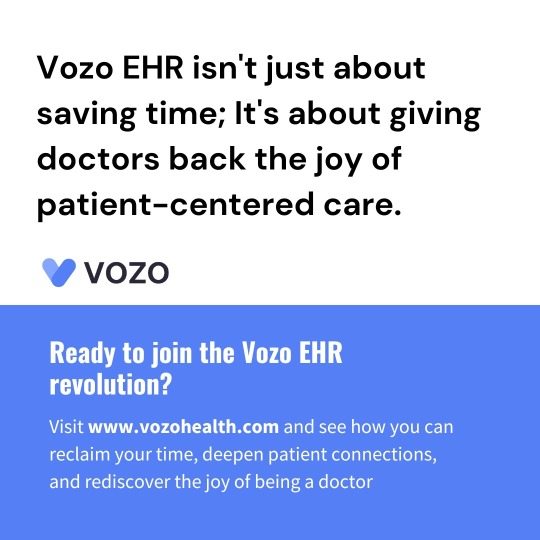
#chronic care management#patient portal#requirements of patient portal#Telehealth#Practicemanagement#Best patient portal#Billing software#patient engagement#mental health#ehr
0 notes
Text
Mirthconnect
Mirth Connect is an open-source, cross-platform integration engine that is used for healthcare data integration. It is developed by Mirth Corporation, which is now a part of the Allscripts healthcare solutions. Mirth Connect is widely used in the healthcare industry to facilitate the exchange of health information between different systems and healthcare organizations.
Key features of Mirth Connect include:
Message Transformation: Mirth Connect allows users to transform messages from one format to another, facilitating interoperability between different healthcare systems that may use different data formats and standards.
Message Routing: The integration engine enables the routing of messages between various systems based on configurable rules. This is crucial for directing healthcare data to the appropriate destinations.
Connectivity: Mirth Connect supports a wide range of communication protocols and standards, such as HL7 (Health Level Seven), DICOM (Digital Imaging and Communications in Medicine), and various web services protocols, making it versatile in connecting different healthcare systems.
Data Mapping: Users can create maps to define how data should be translated and transformed between different systems. This is essential for ensuring that data is accurately represented and understood by the receiving systems.
Alerts and Monitoring: Mirth Connect provides monitoring tools and alerts to notify administrators of potential issues or errors in the data integration process, allowing for quick identification and resolution.
Open Source: Mirth Connect is open-source software, which means that users can access and modify the source code. This flexibility allows developers to customize the integration engine to meet specific organizational requirements.
Community Support: As an open-source project, Mirth Connect benefits from a community of developers and users who contribute to its ongoing development and provide support through forums and other online channels.
Keep in mind that information about specific software can change, so it's advisable to check the official Mirth Connect documentation or community forums for the latest and most accurate information.
0 notes
Text

Electronic Health Records (EHR) refer to digital versions of patients' paper charts, containing their medical history, diagnoses, medications, treatment plans, immunization dates, allergies, radiology images, and laboratory test results. These records are designed to be accessible by authorized healthcare providers and can be shared across different healthcare settings.
Key features and benefits of EHR include:
Centralized Information: EHRs provide a centralized location for health information, making it easier for healthcare professionals to access and update patient data.
Interoperability: EHR systems aim to improve interoperability, enabling different healthcare systems to share and exchange patient information seamlessly. This can enhance the continuity and coordination of care.
Clinical Decision Support: EHRs often include tools for clinical decision support, offering healthcare providers alerts and reminders about potential issues or opportunities for improved patient care based on the data available.
Efficiency: Digital records can streamline administrative tasks and reduce the need for paperwork. This can lead to increased efficiency in healthcare delivery and reduced chances of errors.
Patient Access: Many EHR systems allow patients to access their own health records, fostering patient engagement and empowerment. Patients can review their medical history, test results, and treatment plans.
Security and Privacy: EHRs prioritize security measures to protect patient information. Access controls, encryption, and audit trails are implemented to safeguard the confidentiality and integrity of health records.
Telemedicine Integration: With the rise of telemedicine, EHRs can integrate with virtual healthcare platforms, allowing for the seamless exchange of information between healthcare providers and patients during remote consultations.
Data Analytics and Research: Aggregated and anonymized EHR data can be used for population health management, epidemiological studies, and medical research, contributing to the advancement of healthcare practices and knowledge.
Despite these benefits, challenges related to EHR implementation include issues of data standardization, interoperability among different systems, user training, and concerns about data security and privacy. Overcoming these challenges is crucial to harness the full potential of electronic health records in improving patient care and healthcare outcomes.
#ehr pricing models#ehr software free#cost of implementing ehr in hospital#free ehr software#telemedicine ehr#ehr blog#all in one ehr#best ehr for mental health#ehr practice management software#free ehr#behavioral health ehr#ehr evaluation checklist
0 notes
Text
Telehealth Tactics: Integrating Virtual Visits Functions into Patient Portals for Specialized Practices
Integrating virtual visits into patient portals offers specialized practices a powerful tool to enhance patient engagement, streamline care delivery, and improve patient outcomes. By adopting this approach, practices can position themselves as leaders in patient-centered, technology-driven healthcare.
Learn best practices for optimizing patient portals, connecting devices, developing protocols, educating patients, and more to ensure excellence, operational efficiency, and financial success. Any specialty practice committed to strategic telehealth integration can make a measurable impact on accessibility, convenience, and outcomes.
Let the telehealth experts at Vozo help you transform virtual care capabilities specific to your specialty needs through seamless workflow integration.
To Know More: https://www.vozohealth.com/blog/telehealth-tactics-integrating-virtual-visits-functions-into-patient-portals-for-specialized-practices#more-3382
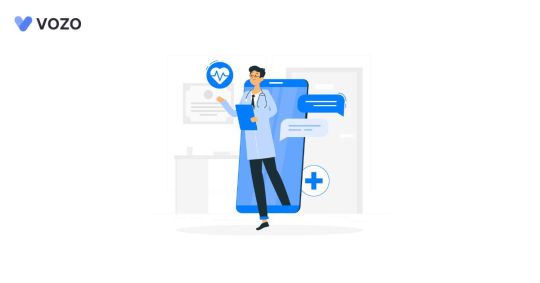
0 notes